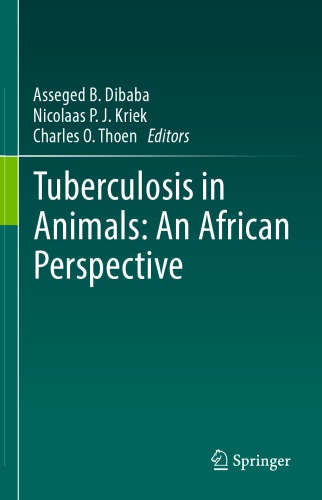Tuberculosis in Animals: An African Perspective 2019
دانلود کتاب پزشکی سل در حیوانات: دیدگاه آفریقایی
| نویسنده |
Asseged B. Dibaba, Charles O. Thoen, Nicolaas P. J. Kriek |
|---|
| تعداد صفحهها |
453 |
|---|---|
| نوع فایل |
|
| حجم |
6 Mb |
| سال انتشار |
2019 |
89,000 تومان
این کتاب زیستشناسی M. bovis و به دنبال آن مورد سل گاوی (bTB) در کشورهای آفریقایی را بر اساس گزارشهای میدانی در مورد بیماریهای مشترک بین انسان و دام و اپیدمیولوژیک بازگو میکند. از آنجایی که انباشت داده ها هیچ ارزشی ندارد مگر اینکه به اقدامات کنترلی عملی منجر شود، تأکید بر پروتکل های سازگار محلی برای کنترل بیماری در آینده است. به منظور ارزیابی سیستماتیک پایگاه دانش bTB، روش اپیدمیولوژیک رویکرد مشکل محور (EPOA) استفاده شد. روش شناسی از دو سه گانه تشکیل شده است: 1) سه گانه شناسایی/شخصیت سازی مشکل، که عمدتاً ماهیت توصیفی دارد، و 2) سه گانه مدیریت مشکل/حل/حل/کاهش، که در درجه اول به سمت مدیریت/حل مشکل گرایش دارد (شکل را ببینید). سه رکن اول شامل سه رکن است: 1) عامل 2) میزبان، و 3) محیط زیست و دوم: 1) درمان/درمان، 2) پیشگیری/کنترل، و 3) حفظ/ ارتقای سلامت. این سه گانه با پیوند دادن روش تشخیصی به یکدیگر مرتبط می شود. مطالعات سیستماتیک و دقیق تعاملات «عامل-میزبان-محیط» بلوک های سازنده برای درک مسیرهای انتقال عامل و گسترش بیماری است. اینها ممکن است شامل داده هایی در مورد وضعیت بیماری در کشور، ماهیت عامل بیماری و میزبان آن، راه های انتقال، مخازن حیات وحش در طبیعت، تداوم آلودگی و بقای عامل در محصولات حیوانی و محیط زیست باشد. سه گانه شناسایی و خصوصیات مسئله این تعاملات را تعریف می کند. هنگامی که مشکل شناسایی شد و به خوبی درک شد، گام بعدی کاهش خطر انتقال و گسترش بیماری است. این حوزه که به عنوان سه گانه حل مسئله/مدیریت نامیده می شود، شامل جایگزین های مدیریت مشکل است که مبتنی بر پیشگیری/کنترل، حفظ سلامت/ارتقای بیماری در دام، حیات وحش و انسان با تمرکز بر کشورهای در حال توسعه فقیر از منابع است. آفریقا. p>
This book recounts the biology of M. bovis, followed by the status of bovine Tuberculosis (bTB) in African countries, primarily based on zoonotic and epidemiological field reports. Since the accumulation of data is valueless unless it led to practicable control measures, emphasis is put on locally adapted protocols for future control of the disease. In order to systematically evaluate the knowledge base of bTB, Epidemiologic Problem Oriented Approach (EPOA) methodology was used. The methodology is composed of two triads: i) the problem identification/characterization triad, which is mainly descriptive in nature, and ii) the problem management/solution/mitigation triad, which is mainly geared toward problem management/solution (see figure). The first triad comprises three pillars: i) agent ii) host, and iii) environment and the second one: i) therapeutics/treatment, ii) prevention/control, and iii) health maintenance/promotion. The two triads are linked together by the diagnostic procedure linkage. The systematic and detailed studies of the ‘Host-Agent-Environment’ interactions are the building blocks to the understanding of agent transmission pathways and disease spread. These may include data about the disease status of the country, the nature of the disease agent and its hosts, the modes of transmission, the wildlife reservoirs in nature, persistence of infection, and agent survival in animal products and the environment. The problem identification and characterization triad identifies these interactions. Once a problem has been identified and well understood, the next step is to minimize the risk of transmission and spread of a disease. This area, referred to as problem solution/management triad, consists of problem management alternatives that rely upon prevention/control, and health maintenance/promotion of the disease in livestock, wildlife, and humans with the emphasis on resource-poor, developing countries in Africa.




